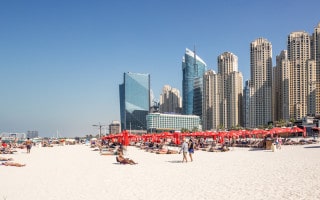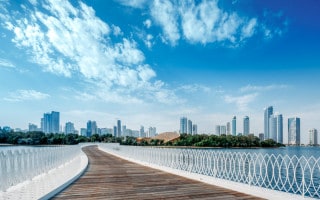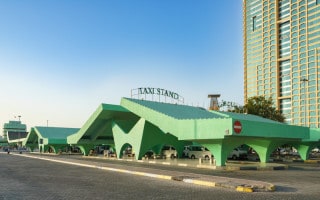Current weather conditions in Abu Dhabi and a 5-day forecast are shown below.
Weather Today in Abu Dhabi - Current Conditions
The current temperature in Abu Dhabi right now is 109°F (43°C).
The wind speed is approximately 4 mph (light breeze), blowing from the north-west. The visibility level now is good. You should be able to see places as far as 6 miles (10 km) away. The humidity level now is roughly 23%.
- Weather conditions: clear sky
- Current temperature: 109°F (43°C)
- Wind speed: 4 mph (6.69 kph)
- Wind direction (blowing from): the north-west
- Relative humidity: 23%
Readings taken on July 27, 2024 at 2:05 pm (Abu Dhabi time).

5-Day Weather Forecast - General Conditions and Temperature
A 5-day weather forecast for Abu Dhabi is shown in the table below.
| Day | Local Time | Conditions | Temp (C) | Temp (F) |
|---|---|---|---|---|
| Saturday 27th July 2024 | 4:00 pm | Clear sky | 40 | 104 |
| Saturday 27th July 2024 | 7:00 pm | Few clouds | 38 | 100 |
| Saturday 27th July 2024 | 10:00 pm | Scattered clouds | 35 | 95 |
| Sunday 28th July 2024 | 1:00 am | Overcast clouds | 34 | 93 |
| Sunday 28th July 2024 | 4:00 am | Overcast clouds | 34 | 93 |
| Sunday 28th July 2024 | 7:00 am | Overcast clouds | 34 | 93 |
| Sunday 28th July 2024 | 10:00 am | Broken clouds | 35 | 95 |
| Sunday 28th July 2024 | 1:00 pm | Broken clouds | 35 | 95 |
| Sunday 28th July 2024 | 4:00 pm | Broken clouds | 35 | 95 |
| Sunday 28th July 2024 | 7:00 pm | Overcast clouds | 35 | 95 |
| Sunday 28th July 2024 | 10:00 pm | Overcast clouds | 35 | 95 |
| Monday 29th July 2024 | 1:00 am | Broken clouds | 34 | 93 |
| Monday 29th July 2024 | 4:00 am | Scattered clouds | 34 | 93 |
| Monday 29th July 2024 | 7:00 am | Clear sky | 34 | 93 |
| Monday 29th July 2024 | 10:00 am | Clear sky | 35 | 95 |
| Monday 29th July 2024 | 1:00 pm | Few clouds | 34 | 93 |
| Monday 29th July 2024 | 4:00 pm | Few clouds | 35 | 95 |
| Monday 29th July 2024 | 7:00 pm | Scattered clouds | 34 | 93 |
| Monday 29th July 2024 | 10:00 pm | Scattered clouds | 34 | 93 |
| Tuesday 30th July 2024 | 1:00 am | Overcast clouds | 34 | 93 |
| Tuesday 30th July 2024 | 4:00 am | Overcast clouds | 33 | 91 |
| Tuesday 30th July 2024 | 7:00 am | Broken clouds | 33 | 91 |
| Tuesday 30th July 2024 | 10:00 am | Overcast clouds | 34 | 93 |
| Tuesday 30th July 2024 | 1:00 pm | Broken clouds | 35 | 95 |
| Tuesday 30th July 2024 | 4:00 pm | Broken clouds | 35 | 95 |
| Tuesday 30th July 2024 | 7:00 pm | Overcast clouds | 34 | 93 |
| Tuesday 30th July 2024 | 10:00 pm | Overcast clouds | 35 | 95 |
| Wednesday 31st July 2024 | 1:00 am | Overcast clouds | 36 | 97 |
| Wednesday 31st July 2024 | 4:00 am | Overcast clouds | 36 | 97 |
| Wednesday 31st July 2024 | 7:00 am | Overcast clouds | 36 | 97 |
| Wednesday 31st July 2024 | 10:00 am | Overcast clouds | 37 | 99 |
| Wednesday 31st July 2024 | 1:00 pm | Overcast clouds | 36 | 97 |
| Wednesday 31st July 2024 | 4:00 pm | Overcast clouds | 36 | 97 |
| Wednesday 31st July 2024 | 7:00 pm | Overcast clouds | 35 | 95 |
| Wednesday 31st July 2024 | 10:00 pm | Overcast clouds | 36 | 97 |
| Thursday 1st August 2024 | 1:00 am | Overcast clouds | 36 | 97 |
| Thursday 1st August 2024 | 4:00 am | Overcast clouds | 36 | 97 |
| Thursday 1st August 2024 | 7:00 am | Overcast clouds | 36 | 97 |
| Thursday 1st August 2024 | 10:00 am | Overcast clouds | 37 | 99 |
| Thursday 1st August 2024 | 1:00 pm | Overcast clouds | 36 | 97 |
Current and Forecast Weather Data: OpenWeatherMap
Forecast - Location Details
The weather forecast for Abu Dhabi is based on data measured at the weather station shown on the map below. The weather in other areas of Abu Dhabi may vary slightly.
Climate
Nestled along the sun-kissed shores of the Arabian Gulf, Abu Dhabi experiences a desert climate with year-round sunshine, warm temperatures, and little rainfall.
To make the most of your trip, we’ve put together a guide on what to expect from the weather in Abu Dhabi, so you can plan accordingly and enjoy all the fantastic city experiences.
Average Temperatures
| Month | High (°C) | Low (°C) | High (°F) | Low (°F) |
|---|---|---|---|---|
| January | 23 | 15 | 73 | 59 |
| February | 25 | 16 | 77 | 61 |
| March | 28 | 18 | 82 | 64 |
| April | 33 | 22 | 91 | 72 |
| May | 37 | 25 | 99 | 77 |
| June | 38 | 27 | 100 | 81 |
| July | 40 | 30 | 104 | 86 |
| August | 41 | 30 | 106 | 86 |
| September | 38 | 28 | 100 | 82 |
| October | 35 | 25 | 95 | 77 |
| November | 30 | 21 | 86 | 70 |
| December | 26 | 17 | 79 | 63 |
The coolest months in Abu Dhabi are January and February, with average high temperatures of 23 °C (73 °F) and 25 °C (77 °F), respectively, and average low temperatures of 15 °C (59 °F) and 16 °C (61 °F). During these months, you can expect pleasant weather perfect for sightseeing and enjoying the city’s outdoor attractions.
As the year progresses, temperatures begin to rise. March through April sees average high temperatures ranging from 28 °C (82 °F) to 33 °C (91 °F), with lows from 18 °C (64 °F) to 22 °C (72 °F). During these months, the weather is still relatively comfortable, especially if you’re exploring the city in the morning or late afternoon.
The hottest months in Abu Dhabi are typically from June to September, with average high temperatures ranging between 38 °C (100 °F) and 41 °C (106 °F) and average low temperatures between 27°C (81°F) and 30°C (86°F). Planning indoor activities or visiting air-conditioned attractions and shopping malls is best during this period. Options include Ferrari World, Louvre Abu Dhabi, Yas Mall, and The Galleria Al Maryah Island.
The best time to visit Abu Dhabi for tourists is during the cooler months, from November to April. During this period, the temperatures are more manageable. These months offer the perfect opportunity to explore the city and its surroundings without the scorching heat, making it easier to enjoy outdoor attractions like Saadiyat Beach, Corniche Beach, and Yas Waterworld.
Humidity Levels
Humidity is a measure of the amount of moisture in the air, and it can significantly impact the comfort of individuals, particularly during outdoor activities. In Abu Dhabi, the humidity levels vary throughout the year.
| Month | Humidity(%) |
|---|---|
| January | 63% |
| February | 60% |
| March | 55% |
| April | 50% |
| May | 49% |
| June | 55% |
| July | 54% |
| August | 52% |
| September | 57% |
| October | 58% |
| November | 59% |
| December | 64% |
As shown in the table above, the months with the highest humidity levels in Abu Dhabi are January and December, with average levels of 63% and 64%, respectively.
In contrast, the months with the lowest humidity levels in Abu Dhabi are April and May, with average levels of 50% and 49%, respectively.
High humidity levels can affect people in a variety of ways. For example, high humidity can make individuals feel hotter, as moisture in the air makes it more difficult for sweat to evaporate from the skin. This can lead to feelings of discomfort, fatigue, and dehydration. Additionally, high humidity can exacerbate respiratory issues such as asthma and allergies and promote mould and bacteria growth.
Rainfall Patterns
Abu Dhabi experiences minimal rainfall, with most months receiving little to no precipitation. The total annual rainfall is relatively low, with the highest amounts occurring during the winter months of January, February, and March.
| Month | Rainfall (mm) | Rainy days per month |
|---|---|---|
| January | 8 | 1 |
| February | 10 | 1 |
| March | 11 | 1 |
| April | 3 | 1 |
| May | 0 | 0 |
| June | 0 | 0 |
| July | 0 | 0 |
| August | 0 | 0 |
| September | 0 | 0 |
| October | 0 | 0 |
| November | 3 | 1 |
| December | 6 | 1 |
In January, there are approximately 8 millimetres of rainfall over one rainy day. February sees a slight increase in precipitation, with an average of 10 millimetres spread across one rainy day. March continues this trend, receiving 11 millimetres of rainfall, typically over one day.
As the year progresses, the amount of rainfall decreases significantly. April experiences a small amount of rain, with 3 millimetres on average and one rainy day. From May to October, Abu Dhabi experiences no rainfall, marking the driest months of the year.
Towards the end of the year, rainfall returns, with November experiencing 3 millimetres of rain over one day. December also receives a small amount of precipitation, averaging 6 millimetres of rainfall over one rainy day.
Sun Hours
Sun hours in Abu Dhabi are plentiful. The emirate enjoys an average of 10.5 hours of sunshine every day.
The number of hours of sun in Abu Dhabi varies throughout the year and is influenced by various factors.
The table below shows the average number of hours of sun per day in Abu Dhabi ranges from 8.4 hours in January to 12.2 hours in June. The number of hours of sun then gradually decreases from July to December, ranging from 12.1 hours to 8.5 hours, respectively.
| Month | Average Hours of Sun |
|---|---|
| January | 8.4 |
| February | 9.4 |
| March | 10.4 |
| April | 11.3 |
| May | 11.9 |
| June | 12.2 |
| July | 12.1 |
| August | 11.6 |
| September | 10.9 |
| October | 10.1 |
| November | 9.4 |
| December | 8.5 |
One of the main factors influencing the number of hours of sun in Abu Dhabi is its latitude. Abu Dhabi is located close to the equator, which means it receives high direct sunlight throughout the year. In addition, the region experiences minimal cloud cover and precipitation, contributing to the high number of hours of sun.
Another factor that influences the number of hours of sun in Abu Dhabi is the season. During the summer, the days are longer, and the nights are shorter, resulting in more hours of sunlight. In contrast, during the winter months, the days are shorter, and the nights are longer, resulting in fewer hours of daylight.
Sunrise And Sunset Times
Sunrise and sunset times and the day length vary significantly throughout the year in Abu Dhabi.
The year’s shortest day occurs in December, with 10 hours and 37 minutes of daylight. In contrast, the year’s longest day occurs in June, with 13 hours and 38 minutes of daylight.
This variation in the length of the day is due to the tilt of the Earth’s axis, which causes the angle of the sun’s rays to change throughout the year.
You can find sunrise and sunset times in Abu Dhabi throughout the year here.
Water Temperature
If you’re planning a trip to Abu Dhabi, you may wonder what the water temperature will be like during your visit. The average sea temperature in Abu Dhabi varies throughout the year, with the warmest water typically found in the summer and the coolest in the winter.
| Month | Water Temperature (°C) | Water Temperature (°F) |
|---|---|---|
| January | 21 | 70 |
| February | 21 | 70 |
| March | 23 | 73 |
| April | 26 | 79 |
| May | 30 | 86 |
| June | 32 | 90 |
| July | 34 | 93 |
| August | 34 | 93 |
| September | 33 | 91 |
| October | 31 | 88 |
| November | 27 | 81 |
| December | 24 | 75 |
The warmest months for swimming in the sea in Abu Dhabi are July and August, with an average water temperature of 34 °C (93 °F). The water temperature remains warm throughout the summer months.
The coldest months are January and February, with an average water temperature of 21 °C (70 °F). While still warm by many standards, this may be too chilly for some visitors to enjoy water activities fully.
You can find the current water temperature in Abu Dhabi here.
Adverse Weather
Like any destination, Abu Dhabi can experience adverse weather conditions that may impact your travel plans.
Sandstorms are a common weather phenomenon in desert regions, and Abu Dhabi is no exception. These storms occur when strong winds lift sand particles from the ground, reducing visibility and creating potential breathing difficulties for those caught in the sandstorm. Sandstorms may last anywhere from several hours to days before dissipating completely.
To protect yourself from the effects of a sandstorm, consider packing a face mask or a scarf to cover your nose and mouth and wear sunglasses to shield your eyes. Keep an eye on local weather reports, and if a sandstorm is predicted, it’s best to stay indoors until conditions improve.
While rainfall is scarce in Abu Dhabi, when it does occur, it can lead to flash floods due to the city’s arid landscape and limited drainage systems. If heavy rain is forecast during your visit, be cautious when venturing outdoors and avoid areas prone to flooding. Staying informed about weather updates and local advisories can help you plan your activities and ensure your safety.
High temperatures, especially during the summer, can lead to heat exhaustion and dehydration. When exploring Abu Dhabi during periods of extreme heat, it’s crucial to stay hydrated, wear loose and light-coloured clothing, and apply sunscreen regularly. Limit your outdoor activities during the hottest parts of the day, typically between 10 am and 4 pm, and opt for air-conditioned indoor attractions or shaded areas. Additionally, take regular breaks to rest and cool down to prevent heat-related illnesses.
Fog is another weather condition that tourists in Abu Dhabi may encounter, particularly during the cooler months from December to February.
Dense fog can significantly reduce visibility and create challenging driving conditions, increasing the risk of traffic accidents. If you are planning to rent a car or drive during your visit, it’s essential to familiarise yourself with safe driving techniques in foggy conditions. These include reducing speed, using low-beam headlights or fog lights, maintaining a safe distance from other vehicles, and avoiding sudden braking or lane changes. Delaying your journey or using public transportation would be best in heavy fog. Taking these precautions ensures your safety and makes your travel experience in Abu Dhabi more enjoyable, even when faced with foggy conditions.
Weather in Other Areas of the UAE
We also offer information about current weather conditions and 5-day weather forecasts in other areas of the UAE; Ajman, Dubai, Fujairah, Ras Al Khaimah, and Sharjah.





